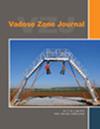非饱和黄土表观接触角的定量实验研究及其在土壤-水特性曲线建模中的应用
IF 2.8
3区 地球科学
Q3 ENVIRONMENTAL SCIENCES
引用次数: 0
摘要
进水角和退水角通常被称为最大表观水接触角和最小表观水接触角,是反映土壤持水能力的关键参数。这些参数在建立非饱和土壤的理论土壤水特性曲线(SWCC)方面发挥着重要作用。然而,在土壤润湿和干燥过程中,由于前进角和后退角与含水量和空隙率密切相关,因此预先假定前进角和后退角不变可能是错误的。针对这一研究空白,我们在不同空隙率和含水量的黄土上进行了系统的实验室测量。使用轴对称液滴形状分析仪获取了表观水接触角,从而获得了全面的数据集。采用方差分析来评估空隙率和含水量之间的显著统计学差异。结果表明,随着空隙率的降低,观察到的水接触角明显增大,而随着含水量的增加,观察到的水接触角有所减小。虽然空隙率和含水量都会影响水接触角,但后者的影响更为明显。据观察,后退水接触角与含水量/空隙率之间呈线性关系。这种线性关系的确定为拟合不同空隙率黄土的 SWCC 提供了启示。这项研究有助于加强理论方法,特别是在适应接触角方面,从而促进开发更精确的 SWCC 模型。本文章由计算机程序翻译,如有差异,请以英文原文为准。
Quantitative experimental study on the apparent contact angle of unsaturated loess and its application in soil–water characteristics curve modeling
Advancing and receding water contact angles, often denoted as the maximum and minimum apparent water contact angles, are crucial parameters reflecting a soil's water holding capacity. These parameters play an important role in establishing theoretical soil–water characteristic curves (SWCCs) for unsaturated soils. However, pre‐assuming constant advancing and receding contact angles during soil wetting and drying processes may be erroneous due to their close correlations with the water content and void ratio. To address this research gap, systematic laboratory measurements were conducted on a loess with different void ratios and water contents. Apparent water contact angles were acquired using an axisymmetric drop shape analyzer, enabling a comprehensive dataset. Analysis of variance was employed to assess the statistically significant differences between void ratios and water contents. The results reveal a significant increase in the observed water contact angle as the void ratio decreases and a decrease with increasing water content. Although both the void ratio and water content influence the water contact angle, the latter has a more pronounced effect. The relationship between the receding water contact angle and water content/void ratio is observed to be linear. The identification of this linear relationship offers insights into the fitting of the SWCC for loess across varying void ratios. This study serves to enhance theoretical methodologies, particularly in the adaptation of contact angles, thus facilitating the development of more precise SWCC models.
求助全文
通过发布文献求助,成功后即可免费获取论文全文。
去求助
来源期刊

Vadose Zone Journal
环境科学-环境科学
CiteScore
5.60
自引率
7.10%
发文量
61
审稿时长
3.8 months
期刊介绍:
Vadose Zone Journal is a unique publication outlet for interdisciplinary research and assessment of the vadose zone, the portion of the Critical Zone that comprises the Earth’s critical living surface down to groundwater. It is a peer-reviewed, international journal publishing reviews, original research, and special sections across a wide range of disciplines. Vadose Zone Journal reports fundamental and applied research from disciplinary and multidisciplinary investigations, including assessment and policy analyses, of the mostly unsaturated zone between the soil surface and the groundwater table. The goal is to disseminate information to facilitate science-based decision-making and sustainable management of the vadose zone. Examples of topic areas suitable for VZJ are variably saturated fluid flow, heat and solute transport in granular and fractured media, flow processes in the capillary fringe at or near the water table, water table management, regional and global climate change impacts on the vadose zone, carbon sequestration, design and performance of waste disposal facilities, long-term stewardship of contaminated sites in the vadose zone, biogeochemical transformation processes, microbial processes in shallow and deep formations, bioremediation, and the fate and transport of radionuclides, inorganic and organic chemicals, colloids, viruses, and microorganisms. Articles in VZJ also address yet-to-be-resolved issues, such as how to quantify heterogeneity of subsurface processes and properties, and how to couple physical, chemical, and biological processes across a range of spatial scales from the molecular to the global.
 求助内容:
求助内容: 应助结果提醒方式:
应助结果提醒方式:


